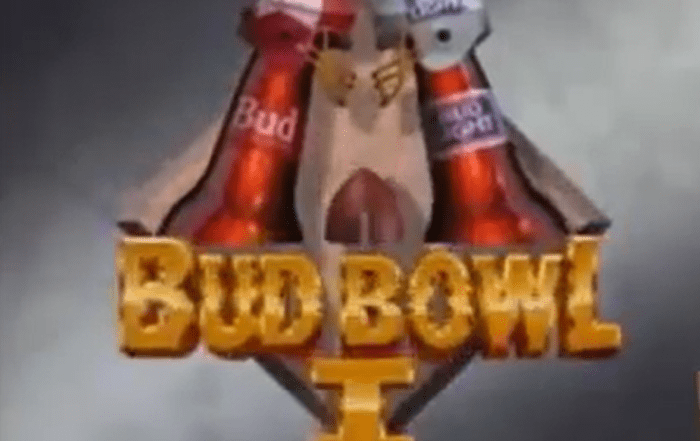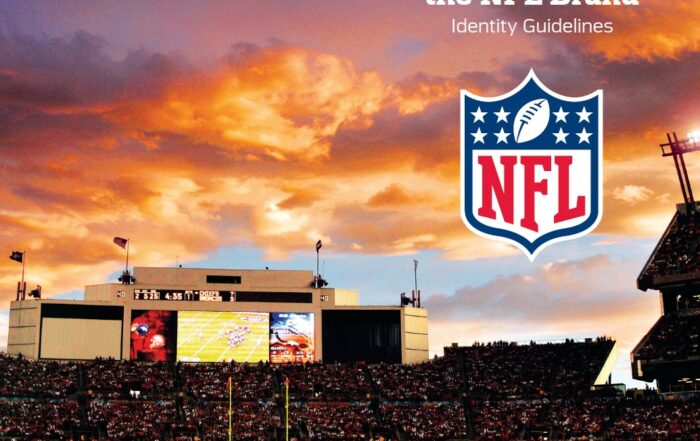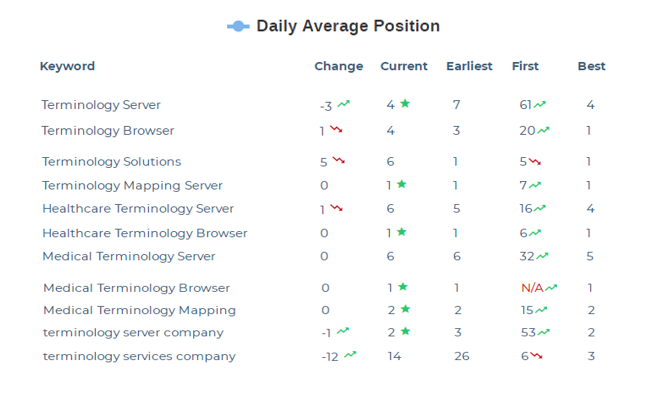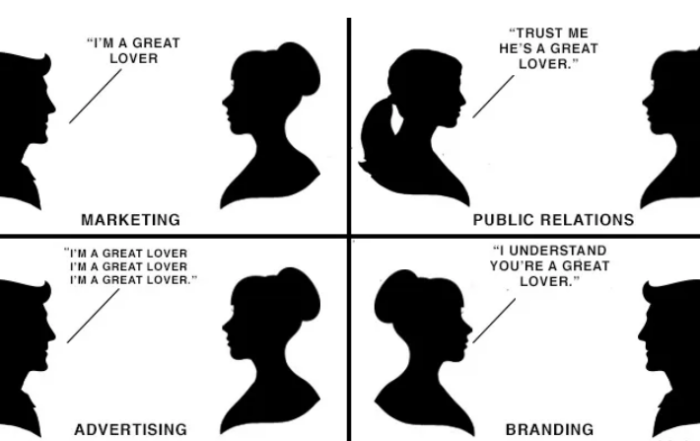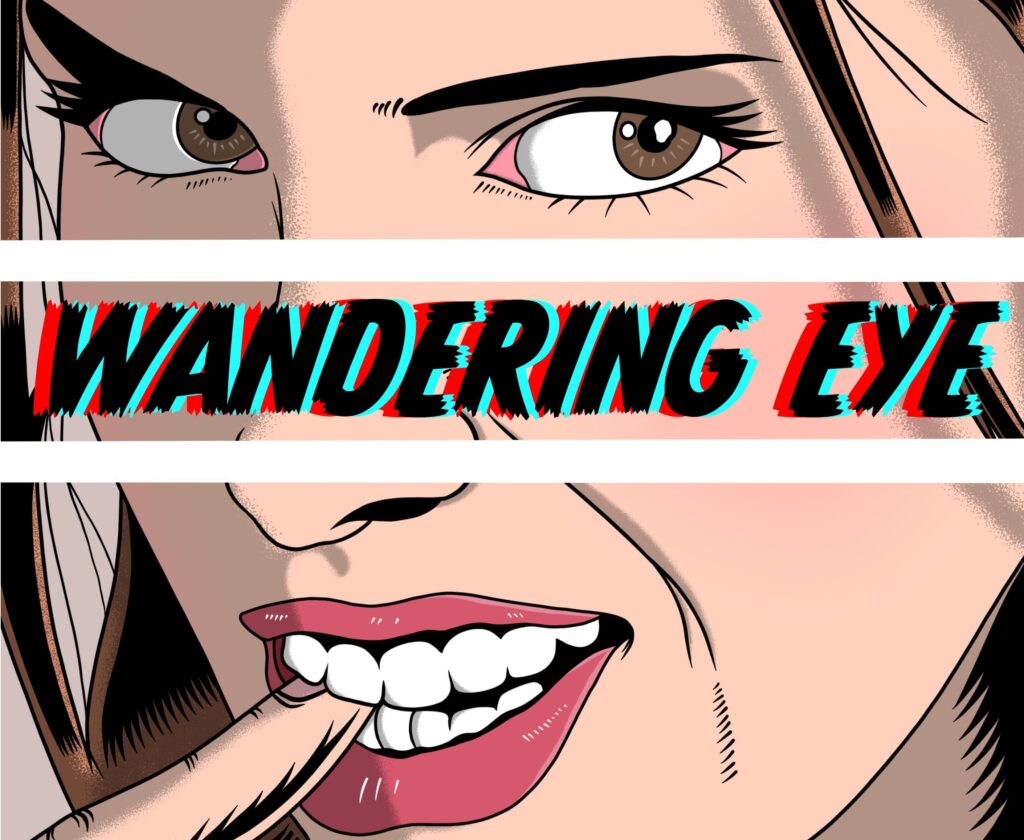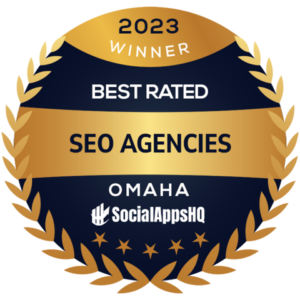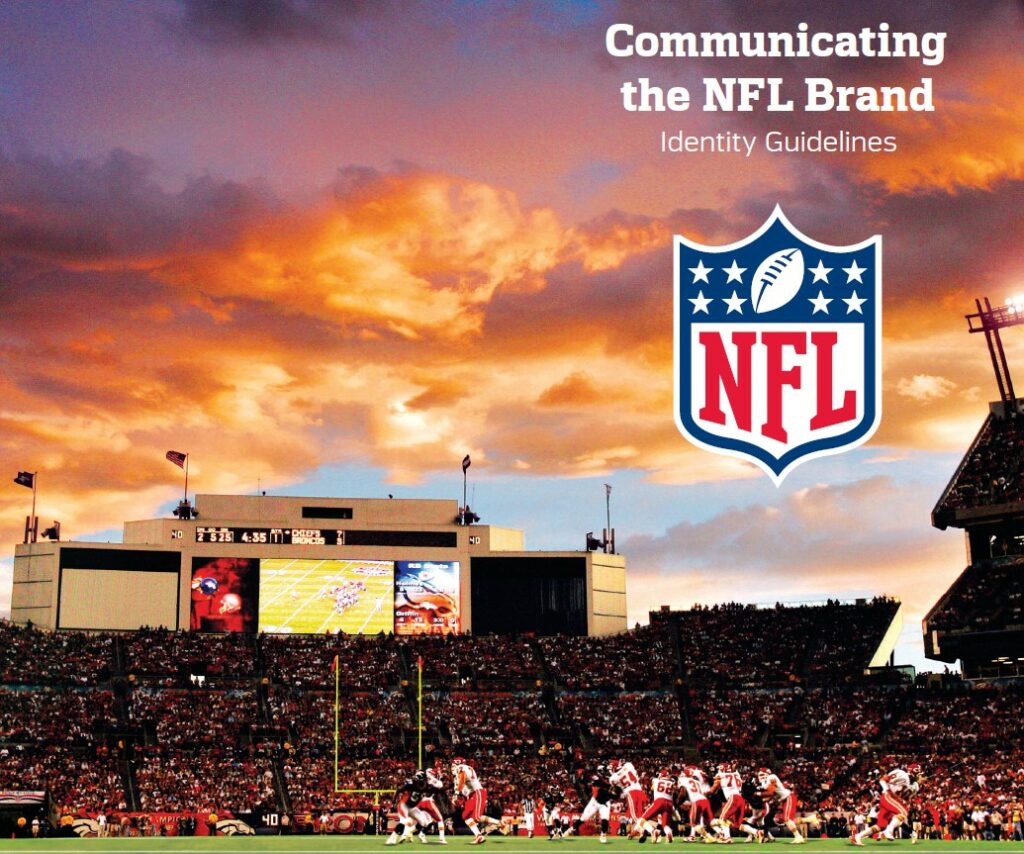
A brand standard guide can also be known as a brand style guide, brand book, brand styling guide, or styling guidelines.
The terminology may differ (and we will use interchangeably in here), but the core goal of each remains the same; to keep a brand “on-brand.”
If you offer one type of brand image on your website, but you portray a completely different one in your physical location, it is confusing and puts customers off. Even if your products or services are superior to your competitors.
Have you ever seen the sports marketing of an officially licensed NFL advertisement, product, packaging, e-blast or social media post that didn’t utilize clean, simple design? Or have the same “feel” regardless of delivery platform?
Probably not.
That’s because the NFL relies on its brand guidelines when broadcasting itself. Which is what every brand is doing all the time; whether they choose to control the perception and experience or not.
Another equally successful brand for non-NFL fans; Apple. Have you ever seen the term “iPhone” advertised as “iphone?” If you did, it was probably a rip-off or made you feel uneasy. That’s how on-brand they are.
Alongside Apple, possibly the best brand going right now is the National Football League (NFL).
A successful brand is based on consistency and authenticity – in all aspects. And a brand style guide covers them all. Like the Cover 2 defense employed by the Chicago Bears and former head coach Lovie Smith during their run to the Super Bowl in 2006.
Being cohesive in all aspects is intentional and the direct reflection of brand strategy. Which is what the brand standards guide embodies.
Take a look at the NFL brand guidelines here. It is 45 pages and gives you everything you need.
Creating a strategy and putting “pen to paper” via the standards are the literal way you build a brand. From there you develop everything from logos, to tone and voice in the text, to photography styles, and typeface.
Chances are, your brand’s standard guide won’t need to be this big. We have worked with several clients that were as condensed as one or two pages. But the key point is to have one.
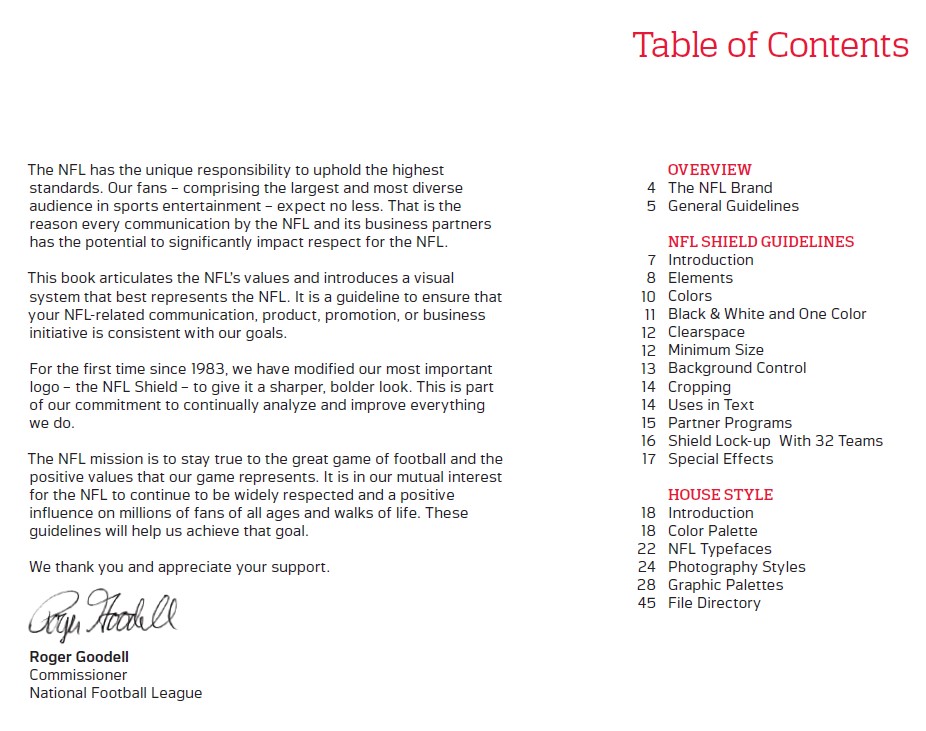
The NFL brand guidelines are 42 pages including a heartfelt note from “Rog.”
What does a brand standards guide include?
Brand guidelines involve a synergistic and intentional approach to defining various elements such as:
1. Visual Consistency: The guide defines the consistent usage of visual elements such as logos, color palettes, typography (fonts and font sizes), imagery styles, iconography, and graphic elements. This ensures that all materials created by different teams or individuals adhere to a unified look and feel.
2. Logo Usage: It provides guidelines on proper logo usage, including variations of the logo (full color, grayscale, black and white), minimum size requirements, clear space around the logo, and rules for placement on different materials.
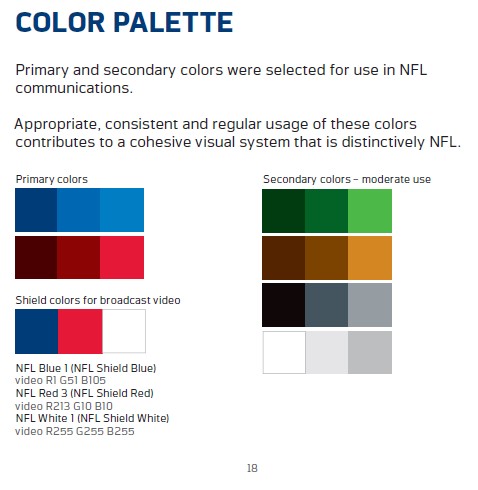
3. Color Palette: The guide specifies the brand’s primary and secondary color palette, along with color codes (RGB, CMYK, HEX) for both print and digital applications. This consistency helps create a recognizable and cohesive brand presence.
4. Typography: It defines the fonts and font sizes to be used for different types of content, such as headings, body text, captions, and more. Consistent typography contributes to the brand’s visual identity.
5. Imagery and Photography: Guidelines for the style and types of images that should be used in brand materials, maintaining a consistent tone, mood, and quality. This helps reinforce the brand’s visual language.
6. Graphic Elements: If the brand uses specific graphic elements or patterns, the guide outlines their proper usage, placement, and scaling.
7. Layout and Design: Principles for creating layouts that are consistent with the brand’s aesthetic, including guidelines for margins, spacing, alignment, and overall design structure.
8. Messaging and Tone: The guide may include guidelines for the brand’s voice, tone, and messaging. This ensures that written content maintains a consistent style and communicates the brand’s values and personality effectively.
9. Digital and Print Applications: It covers various applications, both digital (websites, social media, email templates) and print (business cards, brochures, posters), to ensure that the brand’s visual identity is maintained across different mediums.
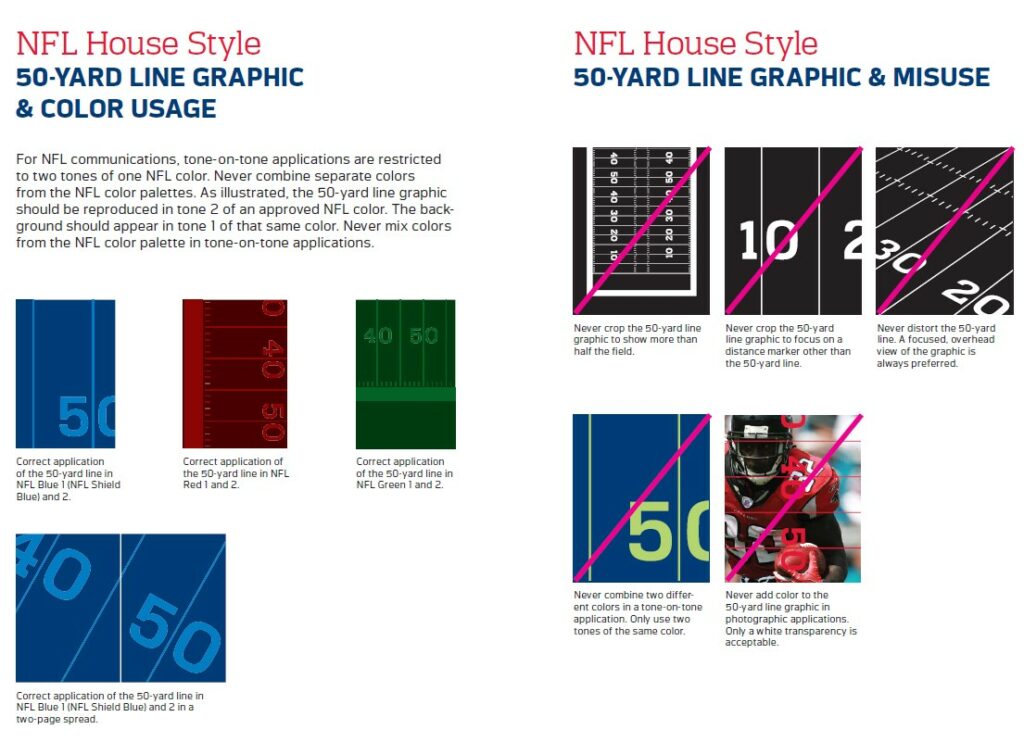
I bet you never knew the NFL had brand standards for 50-yard line application.
10. External Collaborations: When working with external partners, such as agencies or vendors, a brand standards guide helps ensure that they understand and adhere to the brand’s guidelines, maintaining consistency in their work.
11. Onboarding and Training: For internal teams, the guide serves as a resource for new employees, freelancers, or contractors, helping them understand and apply the brand’s visual and messaging guidelines.
12. Legal Protection: Consistently adhering to brand guidelines can also help protect the brand’s intellectual property and trademarks.
The best, biggest brands on earth get this right every time (like the NFL), and in every way (physical, digital, emotional, etc.) a brand is interacted with.
“Culture” – how often have you heard this word used to define a successful business, service or NFL team? Or, why one sucks?
Culture is brand. And the brand standard guide is your brand’s playbook and what your starting quarterback (marketing agency) executers on the field.
So, how did the NFL brand guidelines get developed and how do we help you do it?
Here are the first three steps (with about as many sub categories as there are NFL sub-brands):
Brand Identity – “What are we? Who do we want to attract and work with?”
Brand Values – “What makes ‘us,’ US?”
Brand Standards Guide – “This is what we do every time, all the time.”
Answering the preceding core questions leads us to answers; sometimes hidden in plain sight, sometimes hidden from plain sight.
The process can be cathartic, fun, and a legit team building adventure. Questions that one arm/silo of the organization has a clear understanding of, may be completely misunderstood by another part of the organization.
Once in unison and all paddles are rowing in the same direction, we consider are target audience and employ further techniques like the psychology of color and the psychology of shapes to determine how we broadcast ourselves publicly.
Clearly, this article simplifies a topic that takes work and intentionality.
But if it was simple, every brand would be doing it right and every business would be profitable.
If the NFL can do it, so can you and your brand. A brand at its core is simply a collective of people with the same goals.
Is your brand the Canadian Football League (CFL) to your competitor’s NFL?
Want to do something about it and have questions?
Contact us today and let’s talk.

